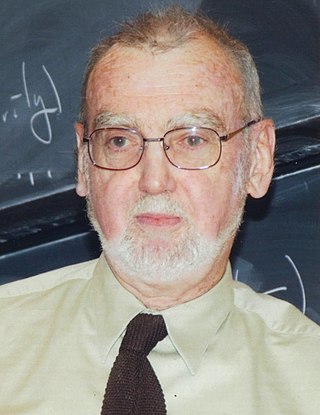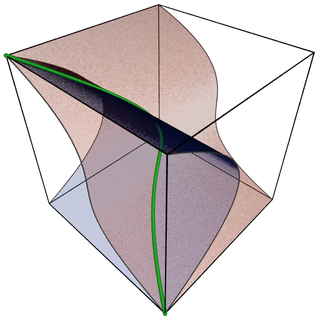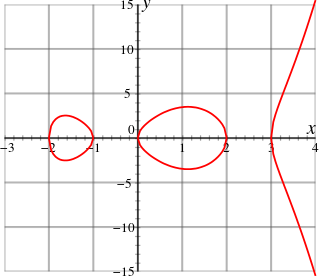
Robert Phelan Langlands, is a Canadian mathematician. He is best known as the founder of the Langlands program, a vast web of conjectures and results connecting representation theory and automorphic forms to the study of Galois groups in number theory, for which he received the 2018 Abel Prize. He is emeritus professor and occupied Albert Einstein's office at the Institute for Advanced Study in Princeton, until 2020 when he retired.
In representation theory and algebraic number theory, the Langlands program is a web of far-reaching and consequential conjectures about connections between number theory and geometry. Proposed by Robert Langlands, it seeks to relate Galois groups in algebraic number theory to automorphic forms and representation theory of algebraic groups over local fields and adeles. Widely seen as the single biggest project in modern mathematical research, the Langlands program has been described by Edward Frenkel as "a kind of grand unified theory of mathematics."
The modularity theorem states that elliptic curves over the field of rational numbers are related to modular forms in a particular way. Andrew Wiles and Richard Taylor proved the modularity theorem for semistable elliptic curves, which was enough to imply Fermat's Last Theorem. Later, a series of papers by Wiles's former students Brian Conrad, Fred Diamond and Richard Taylor, culminating in a joint paper with Christophe Breuil, extended Wiles's techniques to prove the full modularity theorem in 2001.
Gorō Shimura was a Japanese mathematician and Michael Henry Strater Professor Emeritus of Mathematics at Princeton University who worked in number theory, automorphic forms, and arithmetic geometry. He was known for developing the theory of complex multiplication of abelian varieties and Shimura varieties, as well as posing the Taniyama–Shimura conjecture which ultimately led to the proof of Fermat's Last Theorem.
There have been several attempts in history to reach a unified theory of mathematics. Some of the most respected mathematicians in the academia have expressed views that the whole subject should be fitted into one theory.

Algebraic varieties are the central objects of study in algebraic geometry, a sub-field of mathematics. Classically, an algebraic variety is defined as the set of solutions of a system of polynomial equations over the real or complex numbers. Modern definitions generalize this concept in several different ways, while attempting to preserve the geometric intuition behind the original definition.
In mathematics, a modular form is a (complex) analytic function on the upper half-plane, , that satisfies:

Pierre René, Viscount Deligne is a Belgian mathematician. He is best known for work on the Weil conjectures, leading to a complete proof in 1973. He is the winner of the 2013 Abel Prize, 2008 Wolf Prize, 1988 Crafoord Prize, and 1978 Fields Medal.

In mathematics, a linear algebraic group is a subgroup of the group of invertible matrices that is defined by polynomial equations. An example is the orthogonal group, defined by the relation where is the transpose of .
In mathematics, a Galois module is a G-module, with G being the Galois group of some extension of fields. The term Galois representation is frequently used when the G-module is a vector space over a field or a free module over a ring in representation theory, but can also be used as a synonym for G-module. The study of Galois modules for extensions of local or global fields and their group cohomology is an important tool in number theory.
In mathematics, complex multiplication (CM) is the theory of elliptic curves E that have an endomorphism ring larger than the integers. Put another way, it contains the theory of elliptic functions with extra symmetries, such as are visible when the period lattice is the Gaussian integer lattice or Eisenstein integer lattice.
In number theory, a branch of mathematics, a cusp form is a particular kind of modular form with a zero constant coefficient in the Fourier series expansion.
In mathematics, the Ramanujan conjecture, due to Srinivasa Ramanujan (1916, p. 176), states that Ramanujan's tau function given by the Fourier coefficients τ(n) of the cusp form Δ(z) of weight 12
In mathematics, the Hasse–Weil zeta function attached to an algebraic variety V defined over an algebraic number field K is a meromorphic function on the complex plane defined in terms of the number of points on the variety after reducing modulo each prime number p. It is a global L-function defined as an Euler product of local zeta functions.

In mathematics, arithmetic geometry is roughly the application of techniques from algebraic geometry to problems in number theory. Arithmetic geometry is centered around Diophantine geometry, the study of rational points of algebraic varieties.
In mathematics, an Artin L-function is a type of Dirichlet series associated to a linear representation ρ of a Galois group G. These functions were introduced in 1923 by Emil Artin, in connection with his research into class field theory. Their fundamental properties, in particular the Artin conjecture described below, have turned out to be resistant to easy proof. One of the aims of proposed non-abelian class field theory is to incorporate the complex-analytic nature of Artin L-functions into a larger framework, such as is provided by automorphic forms and the Langlands program. So far, only a small part of such a theory has been put on a firm basis.
In representation theory, a branch of mathematics, the Langlands dualLG of a reductive algebraic group G is a group that controls the representation theory of G. If G is defined over a field k, then LG is an extension of the absolute Galois group of k by a complex Lie group. There is also a variation called the Weil form of the L-group, where the Galois group is replaced by a Weil group. Here, the letter L in the name also indicates the connection with the theory of L-functions, particularly the automorphic L-functions. The Langlands dual was introduced by Langlands (1967) in a letter to A. Weil.
In mathematics, the local Langlands conjectures, introduced by Robert Langlands, are part of the Langlands program. They describe a correspondence between the complex representations of a reductive algebraic group G over a local field F, and representations of the Langlands group of F into the L-group of G. This correspondence is not a bijection in general. The conjectures can be thought of as a generalization of local class field theory from abelian Galois groups to non-abelian Galois groups.
In mathematics, Eichler cohomology is a cohomology theory for Fuchsian groups, introduced by Eichler, that is a variation of group cohomology analogous to the image of the cohomology with compact support in the ordinary cohomology group. The Eichler–Shimura isomorphism, introduced by Eichler for complex cohomology and by Shimura for real cohomology, is an isomorphism between an Eichler cohomology group and a space of cusp forms. There are several variations of the Eichler–Shimura isomorphism, because one can use either real or complex coefficients, and can also use either Eichler cohomology or ordinary group cohomology as in. There is also a variation of the Eichler–Shimura isomorphisms using l-adic cohomology instead of real cohomology, which relates the coefficients of cusp forms to eigenvalues of Frobenius acting on these groups. Deligne (1971) used this to reduce the Ramanujan conjecture to the Weil conjectures that he later proved.
Haruzo Hida is a Japanese mathematician, known for his research in number theory, algebraic geometry, and modular forms.










